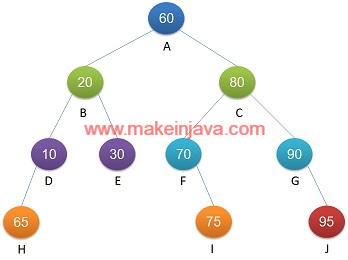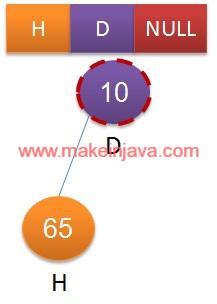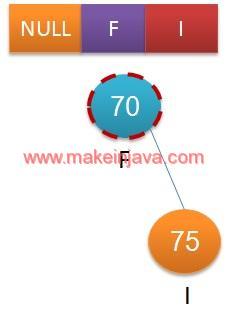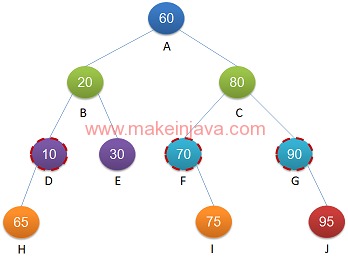- Given a binary tree in java.
- Calculate number of non-leaves having one child node.
- i.e. count the number of nodes in binary tree having either left or right child.
- Traverse the binary tree non recursive algorithm.
- We have already discussed other flavors of current problem:
- Count non leaf nodes in a binary tree having two children (left child & right child).
- Count non leaf nodes in a binary tree (having one child or both children).

Examples: non leaf nodes in binary tree having one child
Example 1 – Non leaf node having left child only

- Iterate through the binary tree using BFS or level order traversal.
- Find non leaf node having left child only?
- The node having non null left child & null right child.
- Get number of non leaf nodes in a binary (having one left child node).
The conditional statement at non leaf node is as follows.
if(nonLeafNode.left != null && nonLeafNode.right==null) { // Leaf node having left child only and right child is null} |
Example 2 – Non leaf node having right child only

The algorithm to count non leaf nodes in a binary tree is similar to example 1. The conditional statement at non leaf nodes is as follows:
if(nonLeafNode.left == null && nonLeafNode.right!=null) { // Leaf node having right child only and left child is null} |
Example 1 & Example 2 conditional statements are sufficient, to calculate number of non leaf nodes having either left or right child in a binary tree.
Example 3 – Non leaf nodes having left child or right child
- Traverse the binary tree using breadth first search algorithm (Fig 4)
- Declare a variable nNonLeaves = 0
- During iteration check, current node has left or right child only (example 1 & example 2).
- nNonLeaves ++ (if non leaf node has left or right child only).
- At the end of iteration, we will number of non leaf nodes having one child node.
- Number of non leaf nodes of binary tree is 3.

Time complexity of algorithm is O(n).
Program: number of non leaf nodes in a binary tree – BFS.
1.) CountNonLeafNodes Class:
CountNonLeafNodes class is responsible for calculating the number of non leaf nodes having one child only using level order traversal (non recursive algorithm).
package org.learn.Question;import java.util.LinkedList;import java.util.Queue;public class CountNonLeafOneChild { public static int countNonLeafOneChild(Node root) { if (root == null) { System.out.println("Tree is empty"); return -1; } int nNonLeaves = 0; Queue<Node> queue = new LinkedList<Node>(); queue.offer(root); while (!queue.isEmpty()) { Node node = queue.poll(); if( (node.left != null && node.right == null) || (node.left == null && node.right != null) ) { nNonLeaves++; } if (node.left != null) { queue.offer(node.left); } if (node.right != null) { queue.offer(node.right); } } System.out.println("Number of non-leaf nodes in a binary tree: " + nNonLeaves); return nNonLeaves; }} |
2.) Node class:
Node Class representing nodes of a binary tree.
package org.learn.Question;public class Node { public int data; public Node left; public Node right; public Node(int num) { this.data = num; this.left = null; this.right = null; } public Node() { this.left = null; this.right = null; } public static Node createNode(int number) { return new Node(number); }} |
3.) App Class:
- Create the binary tree.
- Invoke CountNonLeafNodes method to calculate number of leaf nodes using level order traversal algorithm.
package org.learn.Client;import org.learn.Question.CountNonLeafOneChild;import org.learn.Question.Node;public class App { public static void main(String[] args) { // root level 0 Node A = Node.createNode(60); // Level 1 Node B = Node.createNode(20); Node C = Node.createNode(80); // Level 2 Node D = Node.createNode(10); Node E = Node.createNode(30); Node F = Node.createNode(70); Node G = Node.createNode(90); // Level 3 Node H = Node.createNode(65); Node I = Node.createNode(75); Node J = Node.createNode(95); // connect Level 0 and 1 A.left = B; A.right = C; // connect level 1 and level 2 B.left = D; B.right = E; C.left = F; C.right = G; // connect level 2 and level 3 D.left = H; F.right = I; G.right = J; CountNonLeafOneChild.countNonLeafOneChild(A); }} |
Output : Number of non leaf nodes in binary tree:
Number of non-leaf nodes in a binary tree: 3 |
Code – Non Leaf nodes binary tree (BFS/non-recursive)
